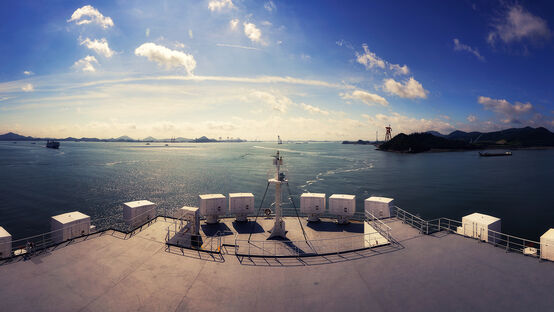How we deliver static cargo wider than Q ramp
Usually when the dimensions of a cargo exceed the ramp width of a vessel, it is inevitable to think that the carrier would turn down the request saying "We are extremely sorry but we cannot help you with your cargo because of its size."
But guess what? That’s not how we approach our breakbulk cargo customers. We try to find the best possible way to handle various type of non-self-propelled cargo from aviation to boats, construction equipment, power generation equipment and railcar and many more. Especially, with the knowledge of ports worldwide and know-hows, our strong team of experts provide safe and smart solutions.
Here’s a noteworthy case of EUKOR handling breakbulk cargo - a cargo wider than q-ramp - in a very brilliant way.
A few weeks ago, relatively big static cargo without wheels arrived at the port of Bremerhaven, Germany. Those cargoes were two big size so-called ‘underhull frames’ bound for a shipyard in Singapore for the construction of a drilling rig. In the first place, simply by looking at the specifications of cargo, measuring 8.4 meters long and 7.2 meters wide, it seemed like the cargo could not fit in to the ramp of our vessel 'Morning Crown' as width of the cargo was wider than the ramp of the vessel.
We received the inquiry for shipment of this cargo from a project forwarder whom we have known for many years. Due to the dimensions of this cargo which exceeded the ramp width of the vessels in position, we needed to find a solution for loading this cargo. We collaborated closely with customer from preparation to executiona customer service agent at STL Shipping the sales agent for EUKOR in Sweden
We collaborated closely with customer from preparation to execution. And after a few times of pre-testing with experts at EUKOR, Eureka! there came a perfect solution from Cargo Superintendent Specialist Mr. Frederic Verhofstede and his team," recalled Mr. Per Moe, a customer service agent at STL Shipping - the sales agent for EUKOR in Sweden. Per also added that "This shows the flexibility of our RoRo solutions and our team looks forward to more oversized cargo inquiries in the future"
Two 40 ft roll-trailers, most commonly used cargo handling equipment that can cater cargo up to 12 meters long and 2.5 meters wide, were used to load this cargo as it could not roll on and off the vessel on its own. If the cargoes were to be handled in the traditional way, we might have transferred cargo from trailer to the handling equipment at the port yard. But it had to be treated differently this time. We placed an empty 40 ft roll-trailer at the entrance of ramp, and then transferred the cargo from trailer by lifting the cargo utilizing a mobile crane at the port.
Simply put, we stuffed the cargo onto the handling equipment on the ramp not at port yard.
The Cargo Superintendent Specialist Mr. Frederic Verhofstede added that “The most noteworthy yet difficult part for loading this cargo at Bremerhaven was that the width of the cargo was slightly wider than the q-ramp. Our team put our heads together and tried to think outside of the box to come up with best solution for this project. Our handling methods focused on minimizing number of switches while loading and discharging process, significantly reducing the risk of damage. We are proud that our way of handling breakbulk cargo advances over time.”
